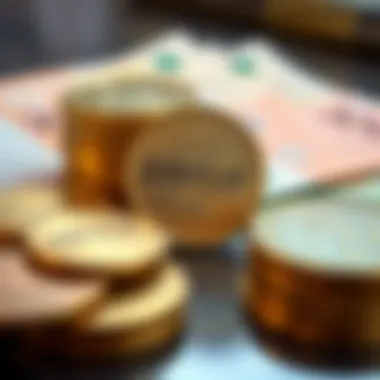Converting 1.8 Million AED to INR: Insights and Implications


Intro
Converting currencies has always been crucial for investors and expatriates, especially in dynamic markets like Dubai. The exchange rate between the UAE Dirham (AED) and the Indian Rupee (INR) shapes financial decisions that can have widespread implications. Understanding how to convert a sizable amount, such as 1.8 million AED to INR, opens up pathways for investors to make informed choices, navigate market trends, and take advantage of opportunities.
The figures aren’t just numbers; they reflect broader economic landscapes. The exchange rate doesn't only fluctuate due to market forces—it’s also intertwined with geopolitical events, oil prices, and other macroeconomic factors. This article takes a closer look at the specifics of the conversion, offering insights that cater to investors, homebuyers, and real estate professionals alike.
In this narrative, we will dissect:
- The nuances of the current exchange rate and its fluctuations.
- Market trends within Dubai’s real estate scene.
- Key factors impacting the value of the Dirham.
- Practical implications for converting AED to INR for investment purposes.
For anyone looking to convert currencies or explore opportunities in Dubai's real estate market, understanding these aspects is not just helpful; it's essential.
Understanding Currency Conversion
Currency conversion is a crucial aspect in today’s globalized economy, especially when dealing with substantial sums like 1.8 million AED. Understanding this process not only helps individuals and businesses navigate financial decisions but also provides insight into the broader economic landscape.
When converting currencies, there are several elements to consider. First and foremost, the accuracy of the exchange rate is key. This rate acts as the bridge between two currencies, determining how much of one currency will be exchanged for another. Misunderstanding or miscalculating this rate can lead to significant financial missteps. Understanding Currency Conversion involves not just the numbers but also recognizing the fluctuations that can occur due to various factors such as market conditions and economic indicators.
In simple terms, a 1.8 million AED transaction isn’t solely about a mathematical equation. It embodies the complexities of international finance, as well as the hopes and ambitions of investors and expatriates. By grasping the nuances of currency conversion, individuals can make well-informed decisions, especially concerning investments and expenditures in foreign markets. This understanding can also aid in financial planning, ensuring that one is prepared for any unexpected changes in exchange rates that might impact savings, purchases, or returns on investments.
The Basics of Currency Exchange
To break it down further, currency exchange is a mechanism that allows individuals or institutions to trade one currency for another. This trade is facilitated by currency exchange markets, which operate around the clock, reflecting economic conditions in real-time. When one person wishes to convert AED to INR, they typically approach an exchange service, such as a bank or a dedicated currency exchange outlet. Through this medium, the value of both currencies at that moment is key.
It’s worth noting that currency values are influenced by various elements, including interest rates, inflation rates, and the economic stability of the countries involved. India’s and UAE’s economic indicators will greatly affect how favorable a conversion may be at any point in time.
Importance of Exchange Rates
Exchange rates serve as an essential tool, acting as a barometer for the economic health of a nation. A strong AED compared to the INR means that it takes less of the Indian currency to purchase Dirhams, which may indicate a robust UAE economy, thriving trade, or significant investments inflow in the region. Conversely, when the AED weakens, it reflects various domestic challenges or perhaps regional economic turbulence.
"Exchange rates are like the pulse of a nation’s economy; when they fluctuate, it’s often a sign of underlying changes that could affect investments, balance sheets, and overall financial wellbeing."
For investors and expatriates, grasping the importance of these rates can lead to sound investment strategies or savings plans. Imagine not being aware that the AED had depreciated slightly. This could mean purchasing less real estate or business opportunities than one initially planned. Monitoring exchange rates closely allows individuals to seize favorable opportunities, thus making the most out of their currency conversion processes.
Current Exchange Rate: AED to INR
Understanding the current exchange rate from AED to INR is crucial for anyone involved in currency conversion, especially if you are considering an investment or relocation in the UAE. This rate not only reflects the buying power of one currency against another but also informs decisions ranging from property purchases to sending money back home.
Tracking Real-Time Rates
When it comes to currency conversion, having access to real-time exchange rates is vital. Fluctuations can happen in a heartbeat due to various factors like market demand, geopolitical events, or economic reports. Here’s how to track these rates effectively:
- Financial News Websites: Platforms like Bloomberg or CNBC provide up-to-date currency rates and market analysis.
- Mobile Apps: Apps such as XE Currency or OANDA can give you immediate access to the latest rates right at your fingertips.
- Bank Websites: Most banks have their own exchange rates listed, but keep in mind these rates could differ from market rates due to transaction fees.
Monitoring these changes means you can make informed decisions, whether you're a frequent traveler, investor, or expat.
Historical Rate Trends
Studying the historical trends of the AED against the INR offers valuable insights into how the currency has moved over time. Such knowledge can provide context to the current rates and help forecast possible future shifts. Here are a few points to consider when examining these trends:
- Long-Term Trends: Look at trends over several years to determine whether the AED has strengthened or weakened against the INR. Major events, like financial crises or oil price fluctuations, often have enduring effects on currency values.
- Seasonal Variations: Certain times of the year can see consistent patterns in exchange rates due to factors like tourism or production cycles.
- Economic Indicators: Pay attention to reports from the UAE and India that may influence the exchange rates. For example, changes in interest rates or GDP growth can sway currency values.
By analyzing both current and historical data, stakeholders can make well-informed decisions regarding their financial moves in this ever-changing market.
"Currency exchange is not just about numbers; it's about understanding the story behind those numbers."


This focus on real-time tracking and historical analysis allows investors, homebuyers, and expatriates to navigate the intricacies of currency conversion more effectively. For deeper insights, you might want to check resources like Investopedia or XE Currency.
Calculating the Conversion Amount
Calculating the conversion amount is a pivotal aspect when dealing with currency exchange. For someone seeking to convert 1.8 million AED to INR, understanding how the conversion works can clarify what that sum really means in terms of purchasing power or investment potential in India. The significance of this calculation extends beyond mere numbers; it embodies the financial strategic planning required for both investors and expatriates. Accurate conversion helps individuals to budget effectively and assess property values, educational costs, or even everyday expenses in a new country. Without a solid grasp of conversion amounts, one might find themselves at a disadvantage, potentially leading to misinformed decisions.
Conversion Formula Explained
The formula for currency conversion is straightforward, yet vital:
Amount in Target Currency = Amount in Source Currency × Exchange Rate
In essence, to convert AED to INR, you simply take the amount you have in AED and multiply it by the current exchange rate of AED to INR. However, this process may not be as simple as it sounds due to the fluctuations in currency value caused by various market factors.
For example, if the exchange rate is 22.0974, then for 1.8 million AED, the calculation would look like this:
1,800,000 AED × 22.0974 = 39,776,520 INR
This output gives a clear picture of the amount you're dealing with; however, it’s crucial to stay aware of current rates, which can change, sometimes drastically, within short periods.
Practical Example of Calculation
Let’s dive a bit deeper into an example that surfaces clarity. Suppose you’re planning to move to India, and you’re considering a property that costs approximately 40 million INR. You would start by calculating how much AED you’d need to convert:
- Find the current exchange rate from a reliable financial website or platform such as XE.com or financial news sources.
- Let’s assume the exchange rate is pegged at 22.5. Now, use the conversion formula:Emphasis on Conversion:
You need to calculate how many AED you need:
Required AED = Target Amount in INR / Exchange Rate
Thus,
Required AED = 40,000,000 INR / 22.5 = 1,777,778 AED
In this example, if you want to buy that property, you will need just under 1.8 million AED. Hence understanding conversion isn’t just a technical exercise; it’s an essential part of making real-world decisions within an international framework.
To sum up, in the world of currency exchange, knowledge is power. Knowing how to calculate conversion amounts can save time, enhance decision-making, and potentially save a good chunk of money.
Factors Influencing Currency Value
When discussing the conversion of an amount like 1.8 million AED to INR, it’s essential to grasp the factors that affect currency values. These elements are more than mere numbers on a screen; they reflect the underlying economic and political realities that shape the market landscape. Understanding these factors provides clarity on why exchange rates fluctuate, which is crucial for investors and expatriates alike, as misjudgments may lead to inadequate planning or unexpected financial surprises.
Economic Indicators
Economic indicators serve as the backbone for assessing a country’s financial health. Consider them as signposts pointing toward future trends in currency exchange rates. Key indicators include GDP growth rates, unemployment figures, inflation rates, and trade balances.
For instance, a robust increase in the UAE's GDP may signal a vibrant economy, which in turn might strengthen the value of the Dirham against the Indian Rupee. Here's how specific indicators can influence currency values directly:
- Inflation Rate: A high inflation rate can erode purchasing power, leading to currency depreciation. Conversely, stable inflation often implies a stronger currency.
- Interest Rates: Higher interest rates offer higher returns on investments, attracting foreign capital and, consequently, strengthening the currency.
- Trade Balance: A country exporting more than it imports tends to see its currency appreciate due to demand for its goods.
Understanding how these indicators interact in the short term as well as the long term can provide insights for those looking to invest or manage currency risk.
Political Stability and Its Impact
Political factors cannot be overemphasized when it comes to currency valuation. A politically stable environment fosters confidence among investors, which usually translates to a stronger currency. In contrast, uncertainty—whether from election cycles, policy changes, or international tensions—can lead to a currency's depreciation.
For example, consider the UAE's relatively stable political landscape compared to other regions. This stability often results in a more favorable perception of the Dirham in the international market. Factors to consider include:
- Government Policies: The coherence and predictability of monetary and fiscal policies influence economic stability.
- Geopolitical Events: Wars, unrest, and conflicts can create volatility in exchange rates, making investors cautious about entering markets.
- Elections and Leadership Changes: Transitions in leadership can either build or undermine confidence, affecting currency performance.
It's important for investors and expatriates to keep an eye on political developments, as these can significantly impact the value of their investments and currency holdings.
Market Sentiment and Investor Behavior
Market sentiment plays an often understated yet potent role in currency valuations. The views and psychology of investors can lead to substantial swings in currency prices independent of fundamental economic conditions. What drives this sentiment?
- News and Reports: Economic forecasts, market analyses, and global news can sway investor confidence. Positive news can lead to currency appreciation, while negative news might trigger sell-offs.
- Speculation: Many investors engage in short-term trades based on predicted movement of currency values. This can create self-fulfilling prophecies where currencies are driven up or down by sheer speculation.
- Trends in Similar Markets: Often, investor behavior in one currency can affect others through correlations. For example, if the Indian economy is on a downturn, and this is generalized in the media, it might weaken the INR, prompting more AED to INR conversions at unfavorable rates.
Market sentiment, while subjective, is something to factor into any financial decision-making process. Keeping a pulse on the psychological aspects of trading can yield dividends in understanding how currencies fluctuate.
"In a world where perceptions can shift at the drop of a hat, relying solely on hard data may not be enough. Knowing the factors beyond the numbers can be a crucial edge."


In summary, recognizing these influencing factors aids in navigating the complex waters of currency conversion. Grasping how economic indicators, political conditions, and market sentiment intersect equips both investors and expatriates to make informed decisions.
The Role of Central Banks
When dealing with currency conversion, understanding the roles of central banks is crucial. They are the gatekeepers of a country’s monetary policy and the main players in ensuring economic stability. This section sheds light on their duties in relation to currency value fluctuations, offering insights pertinent to both investors and expats, especially when converting 1.8 million AED to INR.
Central Bank Policies in the UAE
The Central Bank of the United Arab Emirates (UAE) plays a pivotal role in influencing the value of the Dirham. It does not merely set the exchange rate; rather, it regulates the monetary policy within the country. For example, the central bank may adjust interest rates to control inflation or stabilize the currency, which in turn impacts the amount of INR one would receive when converting AED.
Here are some main points to consider regarding the central bank policies in the UAE:
- Policy Adjustments: The bank regularly reviews its monetary policies to respond to global economic shifts and domestic needs. Adjustments can reflect the current financial climate and impact exchange rates significantly.
- Currency Peg: The Dirham is pegged to the US dollar, which keeps it relatively stable compared to other currencies. This peg helps maintain confidence in the currency, making it crucial for traders and expatriates dealing with currencies like the INR.
- Inflation Control: Through fiscal measures, the central bank aims to maintain inflation rates at optimal levels. An increase in inflation can diminish currency value, which is vital for those looking to convert large sums.
Implementing consistent and forward-thinking policies is what keeps the UAE dirham strong, enabling investors to transition their earnings smoothly into INR.
Indian Central Bank’s Influence on INR
The Reserve Bank of India (RBI) oversees monetary policy for the Indian economy. Its influence on the Indian Rupee’s (INR) value can be felt directly through the decisions it makes regarding interest rates and the money supply.
A few key aspects of how the RBI impacts INR are:
- Interest Rate Decisions: Changes in the RBI's benchmark interest rates can cause fluctuations in the Rupee’s value. When the RBI raises rates, it generally strengthens the INR, making it favorable for those converting AED.
- Market Interventions: Occasionally, the RBI may intervene in currency markets to stabilize or control the value of the INR. This can have a ripple effect on exchange rates, affecting expatriates and investors.
- Economic Indicators: The RBI assesses various economic indicators, including trade deficits and inflation, which can signal potential shifts in currency value. For investors, being aware of these signals can provide foresight into the best times for currency conversion.
Understanding the role of the RBI in shaping INR’s value, in relation to the UAE’s monetary policies, provides a comprehensive backdrop for currency transactions in a global context.
"Central banks are the architects of a nation’s economy, shaping monetary policy to balance growth and stability." - Economic Insights
For more information on the roles of central banks and their impacts, you can visit Wikipedia or the Reserve Bank of India website.
Consequently, grasping these dynamics not only aids in effective currency conversion but also frames a clearer picture of the broader economic landscape for expats and investors navigating the intricate world of currency exchange.
Practical Applications of AED to INR Conversion
Understanding how to convert 1.8 million AED to INR isn’t just about getting a number; it has immediate implications in several realms, particularly for those investing in or living in Dubai. The interplay of currency conversion in practical terms can be a powerful tool in financial decision-making. For investors, fluctuations in currency value can determine the profitability of investments, while for expatriates, knowing the conversion rate is essential for budgeting and financial planning.
Investing in the Dubai Real Estate Market
Investing in the Dubai real estate market can be as inviting as it is complex. With a booming economy, opportunities abound, particularly for expatriates or local investors keen on capitalizing on the luxury properties that line the emirate's skyline. But it’s imperative to keep an eye on the AED to INR conversion — after all, a lot can hinge on the exchange rate at the moment of transaction.
When looking to purchase property, the difference between a favorable exchange rate and an unfavorable one can impact your investment's overall cost. Let’s say the exchange rate stands at 55 INR for 1 AED. This figure leads to a conversion of 1.8 million AED to approximately 99 million INR, a significant amount for any property investment.
Understanding timing is crucial. Exchange rates are dynamic; they can change daily, affected by a host of factors such as economic news or shifts in market sentiment. Keeping track of these rates can yield noticeable differences in your final investment cost. Thus, many investors watch the market closely, comparing the cost of investment now to potential future rates.
"Success in real estate is all about location and timing, and that includes currency timing."
Moreover, potential profits hinge on how the currencies interact. A drop in the value of the AED against the INR could mean you’d acquire more property for less money in your home currency, enhancing your purchasing power.
Financial Planning for Expats
For expatriates residing in Dubai, currency conversion is as practical as it gets. With income likely in AED yet expenses often involving INR (especially for those sending money back home), understanding the conversion process is not merely academic. It’s a lifeline to effective financial management.
- Budgeting: Knowing current exchange rates allows expats to plan their monthly budgets better. If living expenses are calculated in INR against income in AED, then insights into conversion rates can ensure that all bases are covered.
- Remittances: Many expatriates routinely send remittances back to their families in India. Monitoring the AED to INR exchange rate means more money sent home when the rate is favorable.
- Savings: For those saving for future investments or education for children back home, understanding the conversion can maximize savings potential. It may guide decisions on whether to hold funds in dollars, euros, or another currency.
- Emergencies: Currency fluctuations can also impact the ability to cover unexpected expenses. A timely knowledge of rates could lead to better financial flexibility.
- Example: If today’s favorable rate lets you convert 1 AED to 58 INR, sending home 10,000 AED would yield 580,000 INR.


Common Misconceptions and Challenges
Currency conversion is often not just a simple arithmetic exercise. It comes with its own set of misconceptions and challenges that can directly impact financial decisions. Understanding these nuances can help individuals make more informed choices, particularly when converting significant amounts like 1.8 million AED to INR. In this section, we will dissect common misunderstandings around currency exchange and the hidden challenges that can arise.
Misunderstanding Exchange Rates
At the heart of currency conversion lies the exchange rate, but a lot of people don’t fully grasp how it functions. One major misunderstanding is that the rate they see online is necessarily the same rate they’ll get at a bank or an exchange bureau. In fact, rates can fluctuate throughout the day and vary by provider.
Many factors contribute to the exchange rate, including:
- Supply and demand: If more people want AED than INR, the value of AED may rise.
- Economic indicators: Data on inflation, unemployment, and growth rates can sway market sentiment towards a particular currency.
- Political stability: Events like elections or policy changes can lead to rapid fluctuations.
The misconception that a fixed or unchanged rate exists can lure investors into a false sense of security. To get the real deal, thorough market research is vital. Also, websites like XE.com and OANDA provide a better picture of live rates, but again, they should be cross-checked against the actual provider's offered rates.
Fees and Hidden Costs in Currency Conversion
Another pitfall in currency conversion is underestimating the fees involved. People often believe that the exchange rate is the only thing they need to consider. However, there are frequently additional fees or hidden costs that can eat into the conversion amount. These may include:
- Conversion fees: Charges taken by banks or exchanges for facilitating the transaction.
- Service fees: For international transfers or special services like ensuring swift transactions.
- Spread: The difference between the buying and selling price of a currency can also be substantial.
Unfortunately, many individuals overlook these costs until it’s too late. For example, if converting a hefty sum like 1.8 million AED, even a small percentage difference in fees can lead to significant financial losses. Therefore, reviewing the fine print and calculating all potential costs before proceeding is crucial.
Remember: When converting large sums, even minor percentage differences in rates and fees can translate into major monetary losses.
In summary, being aware of these common misconceptions and challenges can make a world of difference in managing currency conversion efficiently. Knowledge equips investors and expatriates with the tools they need to navigate the often murky waters of currency exchange better, ensuring they retain the maximum value from their conversions.
Future Trends in Currency Conversion
As the world becomes increasingly interconnected, the currency conversion landscape is evolving at a rapid pace. This section sheds light on the future trends shaping the currency conversion process, emphasizing the importance of being informed about these changes, especially when dealing with sizable transactions such as converting 1.8 million AED to INR. Investors and expatriates alike can benefit significantly from understanding these trends, which can help them make more informed financial decisions.
Predicting Currency Movements
Predicting currency movements has always been a tricky business, akin to reading tea leaves. However, with advancing analytical methods and tools, it has become a bit less like fortune-telling and more about data analysis. Factors such as economic indicators, interest rates, and geopolitical stability can provide insights into future currency value. For example, if the UAE’s economy shows strong growth, the value of the Dirham might strengthen against the Indian Rupee.
- Technical Analysis: Using historical data to predict future movements can be beneficial. Chart patterns, trend lines, and various indicators offer clues about potential price movements.
- Economic Forecasts: Economist predictions based on thorough research can guide investors. They analyze factors like inflation and unemployment rates to gauge currency strength.
- Geopolitical Events: Political unrest or treaties can drastically affect currency value. Staying abreast of such events can provide a heads-up on potential currency shifts.
Understanding these indicators can reduce uncertainty and give investors a slight edge in a volatile market.
Emerging Technologies in Currency Trading
The currency trading scene is becoming tech-savvy. The introduction of new technologies is enhancing the way traders exchange foreign currencies. These innovations not only improve trading efficiency but also reduce costs, making it easier for smaller investors or expats to manage their finances across borders. A few emerging technologies worth noting include:
- Blockchain Technology: By providing transparency and security, blockchain allows for safer transactions. This tech can also lower transaction fees associated with currency conversion.
- Artificial Intelligence: AI can predict trends and automate trading based on predefined criteria, which is incredibly useful for tracking large currency movements like between AED and INR.
- Mobile Trading Platforms: New apps enable real-time trading and currency tracking from the palm of your hand. This accessibility means individuals can respond quickly to market changes.
Finale and Key Takeaways
Wrapping up our exploration of converting 1.8 million AED to INR, we can see that understanding this topic is not just about numbers on a screen. It's about comprehending how currencies interact, the implications for individuals, especially investors and expats, and realizing the critical role exchange rates play in real-life scenarios.
Currency conversion affects daily life, investment opportunities, and overall financial health—not just for a few, but for many who engage in cross-border transactions. In an age where globalization is escalating, being savvy about these conversions can set one apart.
"Grasping the intricacies of currency conversion can turn potential pitfalls into golden opportunities."
Summary of Key Points
- Understanding Rates: The value of AED compared to INR can fluctuate heavily, influenced by myriad factors including economic indicators, geopolitical stability, and central bank policies.
- Real-World Applications: Whether looking to invest in Dubai's booming real estate market or planning financial strategies as an expatriate, knowing how to convert AED to INR effectively can impact decision making.
- Misconceptions Matter: Common myths surrounding currency conversion can lead to decisions that bust budgets or miss financial goals. Addressing these misconceptions is vital for anyone looking to navigate currency conversions.
- Future Trends: Anticipating changes in currency movements and emerging technologies can provide strategic advantages. Staying informed and adaptable is key.
Implications for Investors and Expats
For investors, understanding the nuances of AED to INR conversion is crucial. The fluctuations in exchange rates can significantly influence return on investment. Every dirham can stretch or shrink in the Indian market depending on the current climate. For expats, particularly those residing in Dubai, the financial landscape is ripe with opportunities, but only for those who are in-the-know.
- Investing Wisely: Knowledge of the conversion rates can help in making informed decisions about investments—be it in stocks or real estate.
- Financial Planning: Understanding the implications of currency conversion allows expats to plan budgets effectively, ensuring that incomes and expenditures in different currencies balance out without surprising dips.
- Navigating Costs: With potential hidden fees in currency conversion, investors and expats need to remain cautious, ensuring they fully understand costs to avoid unpleasant surprises down the line.
By mastering the conversion of AED to INR, one can turn a financial complication into a smooth sailing experience, maximizing benefits in a market that offers so much potential.















